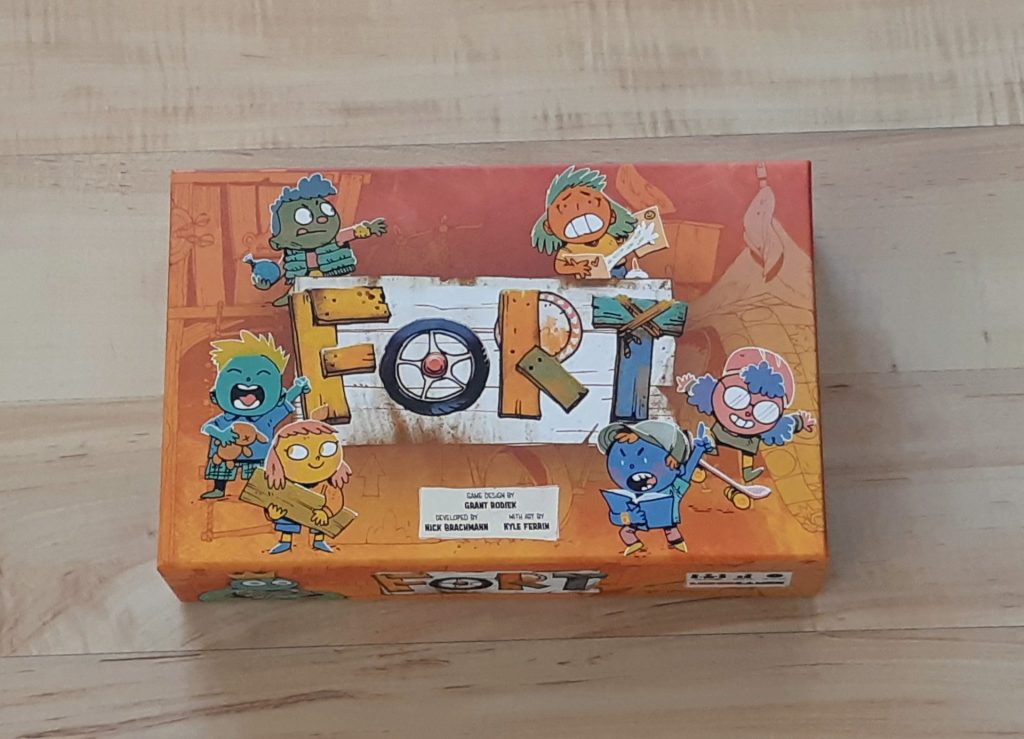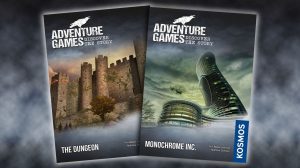When I was a kid I spent all my time outside with my friends playing in my kickass backyard fort that my dad built for me. All the neighbourhood kids and I would group off into teams to have block-wide water fights and massive games of tag and hide and seek. While alliances changed, I always knew I’d have my best friend on my team. Thinking back on these memories, I can pretty confidently say that Fort evokes the feeling of being a kid in the 90s.
In Fort, everyone competes to build the best fort and get the most points. You start the game with a deck of 10 cards, each showing a kid with their own powers. Most of the kids do stuff that helps you build your fort: grabbing resources, recruiting more kids to join your crew, and using those resources to upgrade your fort. You can also earn points during the game through card actions and at the end through your own unique scoring condition.

How to Play
Fort is a deck-building game: you start with a small deck that you’ll add new cards to over the course of the game, but unlike most deck-building games, there is no cost for new cards. Every turn you can snag a card for free from the central pool or other players’ unused cards from their previous hand. That last point adds a little twist: you’re likely to lose cards as well as gain them, which is somewhat unusual in a deck-building game.
But the deck is only half of Fort’s gameplay; in front of each player is a board that tracks their fort building progress, resources, and upgrades. Every step of your fort is built with toys and pizza, which act as the resources in the game. The board will tell you the cost of your next upgrade — always a little more than the last one — and the limits of how much stuff you can hold.
Each turn, there’s a few things that happen:
- Some cleanup (that we’ll ignore for now).
- Play a card — or maybe several. Every card has two actions (called “public” and “private”). You can do one or both. Some cards have a fun multiplier effect: if you play cards of a matching suit, you can perform an upgraded version of the first card’s action. Neat.

- Other people can play a card to copy the “public” action from yours. If they have a card that matches the suit of the one you selected, they get a little mini-turn in the middle of yours.
- Recruit a new kid from the middle of the table or from someone else’s unused cards from their last hand.
- Discard the cards you used, then discard the rest of your hand to your “yard”. During other people’s recruiting phase, these are fair game for them to grab.
- Draw 5 new cards.
When your next turn rolls around, you’ll start by moving anything left in your yard into your discard pile during Step 1 (Some cleanup).
The game continues until someone upgrades their fort to the maximum level, someone hits 25 points, or the deck of kids runs out.
Fun Fort Features
There’s some other stuff going on in Fort that helps make it stand out. We’ll just rattle off a few cool concepts you’ll run into during the game:
- Lookout: Sometimes, cards will let you add other cards to your lookout. On future turns, cards you stashed in here can count towards your multiplier effect if they match the suit of the card you played. The amount of cards you can hide here depends on how much you’ve upgraded your fort.
- Pack: Since the game only lets you store 8 resources (4 pizza, 4 toys), there’s an extra spot to hide your goodies. Stuff in your pack can be used to pay for upgrades, but you’ll need to use cards to put anything in there. Like the lookout, your pack is limited by your fort size.
- Made-up rule: The first time you upgrade your fort, you get to look through a deck of bonus scoring conditions and choose one for the end of the game. You’ll get bonus points for stuff like having lots of toys or lots of kids in your lookout.
- Perk: When you upgrade your fort the second time, you get to choose a unique power that lasts for the rest of the game.
- Best Friends: Some of your starting cards can never be recruited by other players. That’s ‘cause they’re your best friends!
- Macaroni Sculpture: The first person to build their last fort upgrade gets a four point bonus for triggering the end of the game (adorably, this is represented by a macaroni sculpture). Then the current round finishes so everyone gets an equal number of turns.

Thoughts
There is so much to love about this game. Let’s start with the components. Packed into a small box, there are 4 excellent quality player boards. These boards feature cut-outs for your stuff and your fort level. While outlines would have done the trick, Leder Games went the extra mile here. I also really appreciate the player aids. Some of the iconography isn’t exactly obvious, but the large player aids make it quick and easy to identify what the iconography on a card means. I’d be remiss if I didn’t also mention the perfectly thematic artwork by Kyle Ferrin, which really brings the game to life.
The fantastic art of Fort leads us perfectly into our next point: representation. The cards feature so many great different kids. Boys, girls, non-binary. Wheelchair-users are also depicted, which is even more rare than seeing non-male representation. Finally, since all the kids feature the colour of their “suit”, we aren’t bombarded with images of clearly white characters.

I’d also like to talk about the theme. Far too often the games with mechanics that I like feature some sort of colonialism. The absolutely relatable and fun theme of Fort shows that a good game doesn’t need to reinforce systemic-racism. Wow! The theme of Fort is great and supports the gameplay; the rules make sense in the context of the theme.
Now I bet you’d like some thoughts about the actual gameplay too, so here they come! My first concern when learning Fort was aggression. Due to the fact that players can recruit from other players’ yards, the game had the potential to feel very adversarial. This actually turned out not to be a problem at all. Since recruiting happens at the end of each turn, you never feel specifically targeted and you always have the chance to gain back a card that’s lost. Cards will enter your life and leave it, which contributes to the tactical feeling that Fort brings to the table. The addition of the Best Friends also ensures that a player will never lose certain abilities, such as upgrading their fort, just because someone else recruited one of your cards.
I’ve played Fort at all player counts, and while it’s fun at all of them I think it’s best with 3-4. More players means you have more options of cards to recruit. It also feels more balanced with higher player counts. For example, in all my 2-player games the player who upgraded their fort to the final level first and got the Macaroni Sculpture won the game. This was also the only way the game ended in 2-player games, whereas in 3 and 4 player games the possibility of the game ending because the kid deck runs out is higher.

It’s worth noting that Fort was originally published as SPQF, a Roman-themed civilization builder. The game received a complete aesthetic overhaul, but the rules are largely the same. Interestingly, the original theme brings to mind a very different Roman game: Carl Chudyk’s Glory to Rome.
Fans of Chudyk games will find some of the aspects of Fort familiar. Fort’s lookout mechanism, where stashed cards can amplify played cards, echoes similar tableau effects in games like Innovation, Impulse, or Glory to Rome (and its reimplementations). Even Fort’s nested turns, where players can follow each other’s actions, brings these games to mind. With that said, I’d like to point out that while some people need a flowchart to understand how turns work in Chudyk’s games (true story), Rodiek’s turn summary on the player board ensures that players can easily follow every step of a turn and know exactly when they can jump in for public actions. For these reasons, people who enjoy Chudyk games may want to consider using Fort as a step ladder to introduce their friends to these similar concepts.
Now, this comparison isn’t to say that Grant Rodiek copied Chudyk in any way. Fort is a completely unique game. By gathering resources and using them to upgrade your abilities (how much you can store in your backpack and how many lookouts you can have), Rodiek expertly combines familiar mechanics in a way we haven’t seen before.
So pull out your water guns, grab your skateboards, and get ready for an epic neighbourhood battle. Fort is here and it’s ready to transport you away from 2020 to happier years.
Six Month Update
As soon as I could play games with my friends again, this game was on the table. I was eager to show off its fun theme, quick gameplay, and great art. I’m excited for the Cats & Dogs Expansion. Hopefully you’ll be able to read my thoughts on that soon in a standalone review of the expansion.












Looks like this will end up under the tree for my daughter this year. Thanks for yet another smart, helpful review.
This would be great for my grandkids